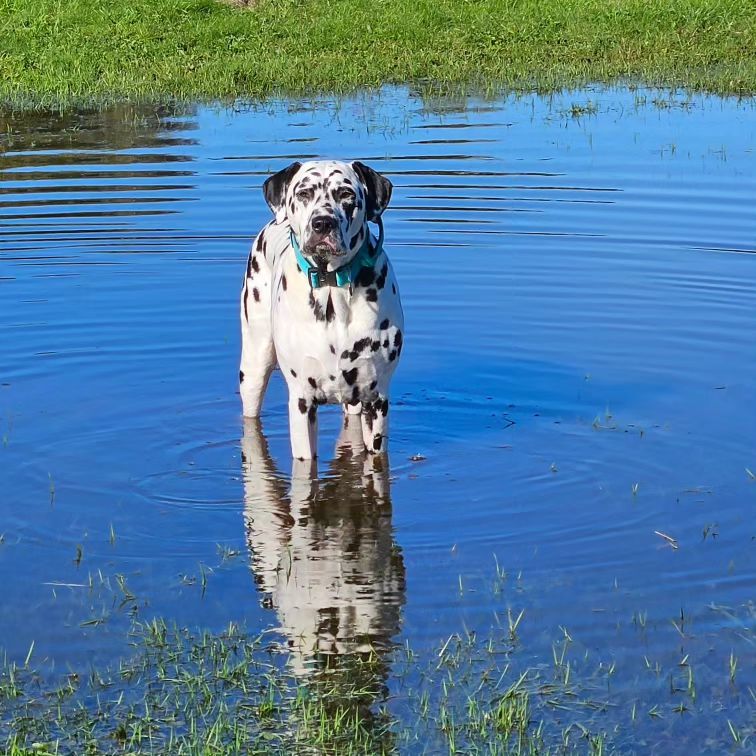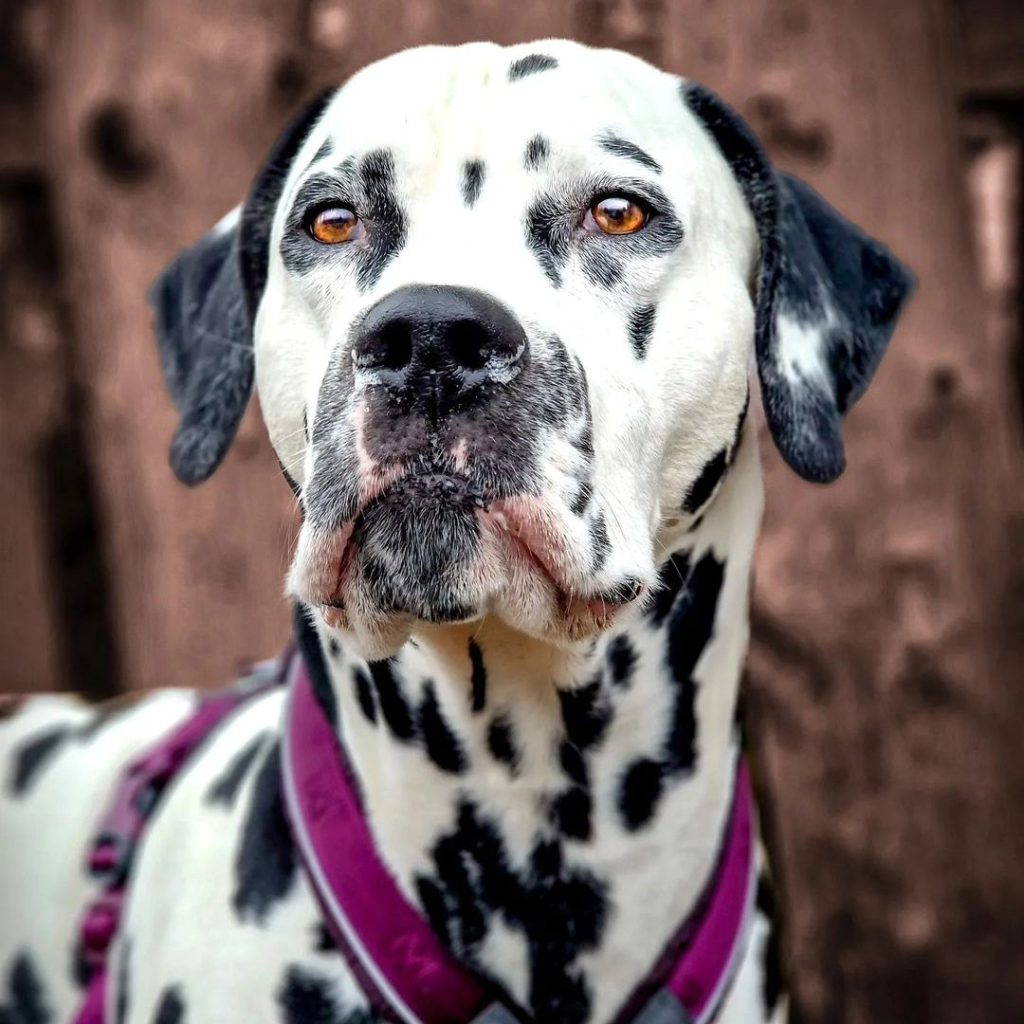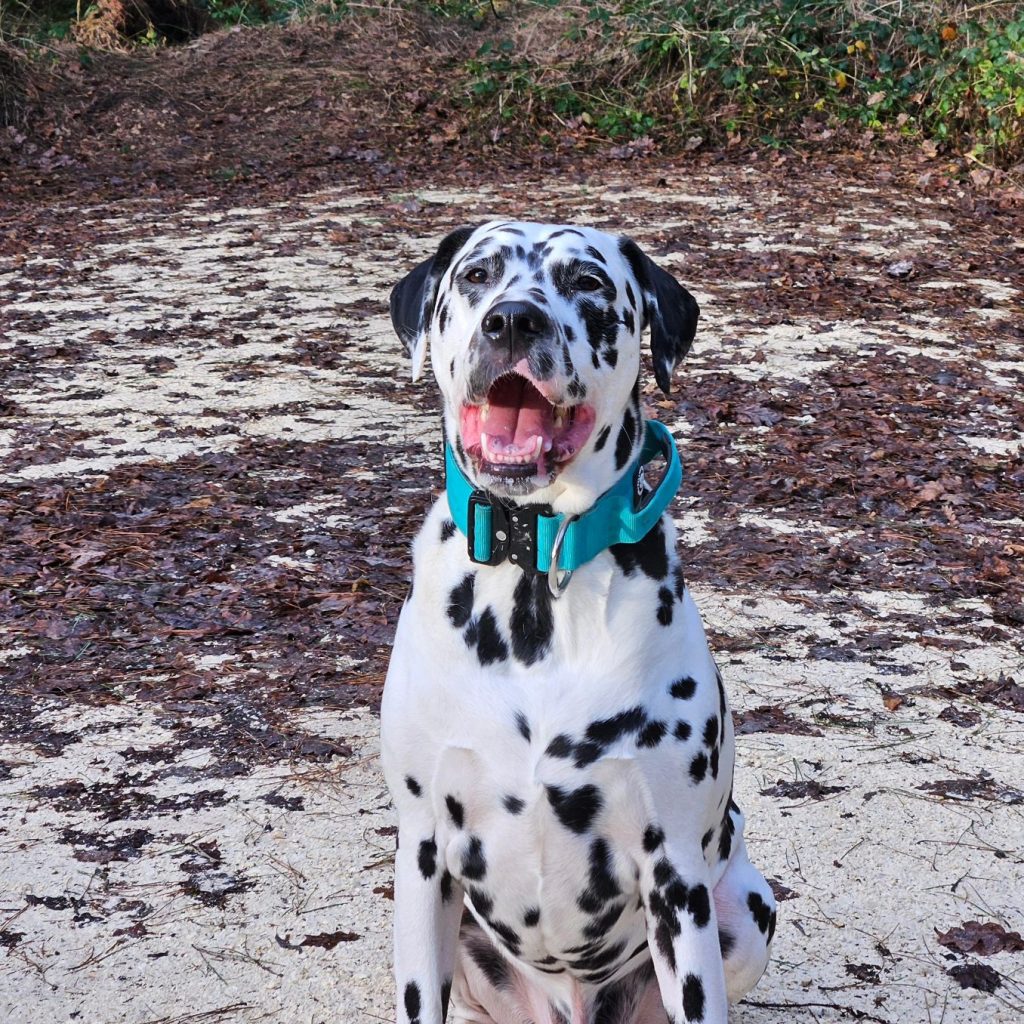The Dalmatian is a breed that captures the heart with its distinctive spotted coat and noble demeanor. Known for its historical role as a carriage dog, the Dalmatian’s unique appearance and energetic personality have made it a beloved companion around the world.

Overview of Dalmatians
Dalmatians are medium-sized, muscular dogs known for their intelligence, alertness, and friendly nature. They possess a striking white coat adorned with black or liver spots, which develop about three weeks after birth. This breed is characterized by its great endurance and speed, attributes that historically made them excellent carriage dogs. Today, Dalmatians are cherished family pets and show dogs, known for their high energy levels and playful disposition.
The Rich History of Dalmatians
The origins of the Dalmatian breed are somewhat mysterious, with various theories suggesting its roots lie in Europe, North Africa, or Asia. The breed’s name, however, is commonly believed to be derived from the historical region of Dalmatia, in present-day Croatia, where they were once known to roam. Throughout history, Dalmatians have served in many roles, from hunters and shepherds to the famed carriage dogs of British nobility. They would run alongside or beneath the axles of coaches, serving as both protectors and status symbols for their owners.
Physical Characteristics of Dalmatians
Appearance: What Do Dalmatians Look Like?
- Coat: Their most defining feature is their short, dense, fine, and glossy coat adorned with unique black or liver spots. The spots are well-defined and evenly distributed, varying in size from the size of a dime to the size of a half-dollar.
- Color: The base color of their coat is pure white, with spots starting to develop when they are about three to four weeks old.
- Head: They have a well-defined, smooth head with a moderate stop, and their ears taper towards the tip, carrying spots like the rest of their body.
- Eyes: Dalmatians’ eyes are round, and bright, and can vary in color from dark brown in black-spotted Dalmatians to amber in liver-spotted ones. Some may even have blue eyes or a combination of blue and another color.
- Tail: Their tails are fairly long, following the line of the back, and are carried with a slight upward curve but not curled.
Size: Understanding the Stature of Dalmatians
- Height: The average height for male Dalmatians ranges from 22 to 24 inches at the shoulder, while females tend to be slightly smaller, standing about 20 to 22 inches tall.
- Weight: In terms of weight, males typically weigh between 45 to 70 pounds, and females weigh slightly less, ranging from 40 to 60 pounds.
- Body: Their bodies are well-proportioned, with a level back and a strong, muscular build, which contributes to their agility and endurance.
The Dalmatian Personality and Behavior
General Temperament of Dalmatians
Dalmatians are known for their outgoing and friendly nature, making them excellent companions. They possess a high level of energy and enjoy being part of every family activity. With a strong sense of loyalty, Dalmatians often form an intense bond with their owners and can be very protective. Their temperament is also marked by playful and sometimes mischievous behavior, which requires consistent training and socialization from an early age to ensure they become well-mannered adults.
Exercise and Playfulness: Meeting the Energy Needs of Dalmatians
Dalmatians have a storied history of running alongside carriages, and this endurance is still part of their makeup today. They require regular, vigorous exercise to keep them physically and mentally stimulated. A lack of activity can lead to destructive behavior due to boredom. Playfulness is ingrained in their personality, making them great playmates for children, although their energy levels should be monitored to ensure safe interactions. Activities like running, hiking, and agility training are excellent ways to satisfy their exercise needs while strengthening your bond.
Intelligence and Trainability: Tips for Effective Training
Dalmatians are intelligent and capable learners who respond well to positive reinforcement techniques such as treats, praise, and play. Their smart and sometimes stubborn nature can make training a challenge, requiring patience and consistency. Early socialization and obedience training are crucial for Dalmatians, as they help in shaping a well-behaved and sociable dog. Engaging their minds with puzzle toys and interactive games can also help in positively harnessing their intellectual energy.
Social Traits: Dalmatians with Families, Kids, and Other Pets
With their affectionate nature, Dalmatians make excellent family pets. They typically get along well with children, often matching their energy and enthusiasm for play. However, it’s important for interactions to be supervised, especially with younger children, to ensure playtime remains gentle and safe. Dalmatians can also coexist peacefully with other pets, especially if raised together from a young age. Their sociable demeanor, however, requires proper introduction and socialization to prevent any jealousy or competitive behavior.
Behavioral Considerations: Barking, Prey Drive, and More
While Dalmatians are not known for excessive barking, they will alert their owners to anything unusual, making them excellent watchdogs. They have a moderate prey drive, which can be managed with proper training and socialization. Teaching them reliable recall commands is essential, especially if they are to be let off-leash. Potential owners should also be aware of their sensitivity; Dalmatians thrive on companionship and can become anxious if left alone for extended periods. Understanding these behavioral traits is key to providing a nurturing environment that caters to their physical and emotional needs.
Health and Care for Dalmatians

Grooming Needs: Coat Care and Shedding
Despite their short coat, Dalmatians shed year-round, with heavier shedding seasons in the spring and fall. Regular brushing, at least a few times a week, can help manage the shedding and keep their coat healthy. During shedding season, more frequent brushing may be necessary to keep hair off your clothes and furniture. Bathing should be done as needed, but not so frequently as to strip the coat of its natural oils. Regular ear checks and nail trims are also important parts of the grooming routine to prevent infections and discomfort.
Health Concerns in Dalmatians and Recommended Screenings
Dalmatian puppies and adults are generally healthy, but like all breeds, they’re prone to certain health conditions. Deafness, either partial or complete, is relatively common in the breed. Urinary stones and skin allergies are also concerns. Responsible breeders will screen their breeding dogs for conditions such as hip dysplasia, eye abnormalities, and deafness. It’s recommended for Dalmatian training to include socialization with various people and environments to promote emotional health and prevent anxiety.
Lifespan: How Long Do Dalmatians Live?
The average lifespan of a Dalmatian is around 10 to 13 years. Some Dalmatians can live even longer with proper care, regular veterinary check-ups, and a healthy lifestyle. A balanced diet, regular exercise, and early detection of potential health issues are key factors in promoting a long, healthy life for these energetic dogs.
Managing Potential Weight Gain
Dalmatians are active dogs that require regular exercise to maintain a healthy weight. An appropriate balance of physical activity and diet is crucial for preventing obesity, which can lead to other health problems. Monitoring food intake, including treats, and providing daily exercise, such as walks, runs, or playtime, can help manage their weight effectively.
Addressing the Specific Needs of Sensitive Dalmatians
Dalmatians can be sensitive, both physically and emotionally. They thrive on companionship and do not like being left alone for long periods, which can lead to separation anxiety. Creating a supportive environment, including regular interaction, mental stimulation, and Dalmatian training, can help address their emotional needs. Additionally, being mindful of their diet and environmental factors can help manage sensitivities such as skin allergies.
Living With a Dalmatian
The Dalmatian in Your Home: Adaptability to Apartment Living
Dalmatians are highly adaptable dogs with the right amount of exercise and mental stimulation. While they can live in apartments, their energy levels and need for regular activity mean they thrive best in environments where they can move freely. A home with a securely fenced yard is ideal, but Dalmatian breed owners living in apartments can ensure a happy, healthy dog through multiple daily walks, runs, and engagement in activities like agility training or interactive play sessions.
Compatibility with First-Time Dog Owners
Dalmatians can be a good match for first-time dog owners who are prepared for the high energy and commitment required for Dalmatian training and care. Their intelligent and trainable nature makes them responsive to consistent, positive reinforcement training methods. First-time owners should educate themselves on the breed’s needs, including their exercise requirements, potential health issues, and the importance of early socialization and training to ensure a well-behaved companion.
Coping with Separation: Tips for Leaving Dalmatians Alone
Dalmatians are known for their loyalty and can struggle with separation anxiety if left alone for extended periods. Here are some tips to help your Dalmatian cope when you’re away:
- Establish a Routine: Consistent departure and arrival times can help reduce anxiety.
- Provide Plenty of Exercises: A well-exercised Dalmatian is more likely to rest while you’re away.
- Leave Engaging Toys: Puzzle toys or treat-dispensing toys can keep them occupied.
- Consider Crate Training: A crate can provide a safe space for your Dalmatian if introduced properly.
- Doggy Daycare or Dog Walkers: These can be excellent options for keeping your Dalmatian socialized and active.
Weather Tolerance: Preparing for Cold and Hot Climates
The Dalmatian breed has a short, dense coat that offers some protection against the elements, but they are more suited to moderate climates. In cold weather, a dog coat or sweater can help keep them warm during outdoor activities. In contrast, their light coat makes them somewhat vulnerable to overheating in hot climates. Ensure they have access to shade and fresh water, and avoid strenuous exercise during the hottest parts of the day. Always be mindful of the signs of heatstroke or hypothermia, as Dalmatians, like all dogs, can be susceptible to extreme temperatures.
Training and Mental Stimulation
Training and mental stimulation are crucial for the well-being and development of a Dalmatian. Given their Dalmatian size and Dalmatian height, these dogs are not just physically imposing but also possess a keen intellect that requires regular engagement. This section delves into effective training routines, the importance of mental stimulation, and managing their instincts such as high prey drive and mouthiness.
Establishing a Training Routine: Guidelines and Strategies

Creating a structured training routine is essential for Dalmatians, helping them understand expectations and thrive in their environment. Here are some guidelines and strategies for effective training:
- Start Early: Begin training as soon as your Dalmatian puppy arrives home. Early training and socialization set the foundation for a well-behaved adult dog.
- Be Consistent: Use consistent commands and rewards to reinforce desired behaviors. Consistency helps your Dalmatian understand and follow rules.
- Positive Reinforcement: Reward good behavior with treats, praise, or playtime to encourage repetition of those behaviors.
- Short, Engaging Sessions: Keep training sessions short and engaging to maintain their attention. Dalmatians are intelligent and learn quickly but can become bored with repetition.
- Socialization: Expose your Dalmatian to various people, animals, and environments to develop a well-rounded and sociable dog.
Mental Stimulation for the Intelligent Dalmatian
Mental stimulation is as important as physical exercise for the intelligent Dalmatian. Engaging their minds helps prevent boredom and destructive behaviors:
- Puzzle Toys: Use toys that challenge them to think and problem-solve.
- New Tricks and Commands: Regularly teaching new tricks and commands keeps their mind engaged and strengthens your bond.
- Interactive Games: Games like hide-and-seek or fetch that require them to think and move are great for mental and physical stimulation.
- Agility Training: This can provide both mental and physical exercise, enhancing their agility, problem-solving skills, and obedience.
Addressing High Prey Drive and Mouthiness
Dalmatians, with their historical roles as hunting and carriage dogs, may exhibit a high prey drive and mouthiness. Here’s how to manage these instincts:
- Structured Play: Engage in play that uses toys instead of hands to discourage mouthiness. Teach “drop it” and “leave it” commands to control mouthing behavior.
- Prey Drive Management: Keep your Dalmatian on a leash in areas with wildlife. Train them to respond to recall commands promptly, and use fenced areas for off-leash play.
- Redirect the Behavior: Provide appropriate outlets for their prey drive, such as fetch or tug-of-war, where they can chase and catch without negative consequences.
- Professional Training: If these behaviors become challenging, consider seeking help from a professional dog trainer who uses positive reinforcement methods.
Integrating a Dalmatian Into Your Life

Welcoming a Dalmatian into your life is an exciting journey that requires consideration of their unique needs and Dalmatian temperament. Known for their high energy levels and sensitivity, Dalmatians thrive in environments where they can be active and engaged. This section will explore effective exercise strategies, the importance of socialization, and how to manage their sensitivity to ensure a harmonious integration into your life.
Exercise Strategies for the Active Dalmatian
Dalmatians possess a remarkable level of stamina and energy, making regular and varied exercise crucial:
- Daily Walks and Runs: Aim for at least one to two hours of exercise daily, including walks, jogs, or runs, to help burn off their abundant energy.
- Interactive Play: Engage in interactive play sessions that stimulate both their body and mind, such as fetch, frisbee, or tug-of-war.
- Agility Training: This not only provides physical exercise but also mental stimulation, making use of their intelligence and agility.
- Swimming: Many Dalmatians enjoy water, and swimming can be a great low-impact exercise, especially for those with joint concerns.
Enhancing Socialization: Tips for Raising a Dog-Friendly and Stranger-Friendly Dalmatian
Socialization is key to raising a well-adjusted Dalmatian who is comfortable around other dogs and people:
- Puppy Socialization Classes: Enroll your Dalmatian in puppy classes to expose them to different dogs and people in a controlled environment.
- Regular Dog Park Visits: If your Dalmatian is comfortable around other dogs, regular visits to the dog park can provide socialization and exercise.
- Positive Experiences: Ensure that interactions with new dogs and people are positive. Use treats and praise to reinforce good behavior.
- Controlled Introductions: When introducing your Dalmatian to new situations, do so gradually and in a controlled manner to prevent overwhelming them.
Understanding and Managing the Dalmatian’s Sensitivity Level
Dalmatians are known for their sensitive Dalmatian temperament, which requires a thoughtful approach:
- Positive Reinforcement: Respond best to positive reinforcement techniques. Harsh methods can be detrimental to their emotional well-being.
- Routine and Stability: Thrive on routine and stability. Keeping a consistent schedule for feeding, walking, and playtime can provide a sense of security.
- Calm Environment: Strive to maintain a calm and supportive home environment. They are sensitive to stress and can mirror the emotions of their household.
- Patience and Understanding: Be patient and understanding of their sensitivities. Recognize signs of stress or discomfort and adjust the environment or activity accordingly.
Supporting Your Dalmatian’s Well-being

Safety Tips for Dogs with a Tendency to Wander
Dalmatians, curious and energetic, may wander if given the chance. Secure fencing is essential to prevent escape. Microchipping and up-to-date ID tags can aid in their safe return should they get lost. Training your Dalmatian to respond to recall commands can also be a vital safety measure for those moments when they might get too curious or adventurous.
Effective Management of High-Energy and High-Intensity Dogs
Managing a high-energy Dalmatian requires a combination of physical exercise and mental stimulation. Daily activities such as long walks, runs, and interactive play sessions are crucial. Incorporating training sessions into playtime can help burn off energy while also reinforcing obedience. Structured activities, like agility courses or dog sports, can provide an outlet for their intensity, ensuring they remain happy and healthy.
Breed-Specific Legislation and the Dalmatian
Breed-specific legislation (BSL) often targets specific breeds deemed dangerous, but Dalmatians are generally not affected by such laws. As advocates against BSL argue for fair treatment of all breeds, understanding and education about the Dalmatian’s nature are essential in promoting positive perceptions and preventing unfair legislation.
